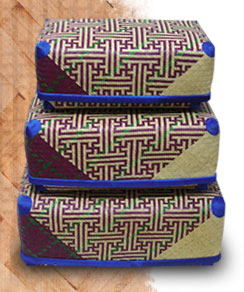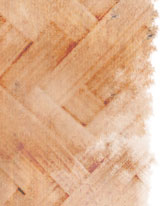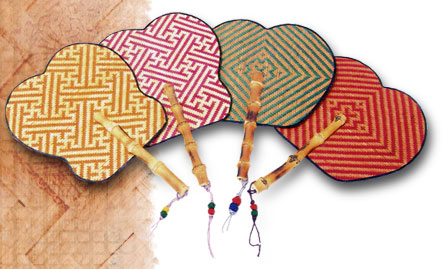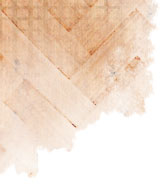 Bamboo,
an elegant and graceful plant symbolic of North East Asia, is typically
recreated by artists’ Bamboo,
an elegant and graceful plant symbolic of North East Asia, is typically
recreated by artists’
 brushes and paints on canvas, paper or ceramic. But instead, one craftsman
cut the bamboo into
brushes and paints on canvas, paper or ceramic. But instead, one craftsman
cut the bamboo into
 strips as thin as paper, dyed them, and with deft fingers wove them into
delicate, yet strong, boxes and
strips as thin as paper, dyed them, and with deft fingers wove them into
delicate, yet strong, boxes and
 baskets. These pieces of classic beauty and extraordinary detail cannot
be made by any artisan―they
baskets. These pieces of classic beauty and extraordinary detail cannot
be made by any artisan―they
 breathe the soul of their Master and Creator who weaves his life experiences
in with each strip.
breathe the soul of their Master and Creator who weaves his life experiences
in with each strip.
 Chaesangjang
is an honorary title given by the Korean government to a master craftsperson
who Chaesangjang
is an honorary title given by the Korean government to a master craftsperson
who
 possesses a high level of skill and knowledge in the Korean traditional
art of weaving colored bamboo
possesses a high level of skill and knowledge in the Korean traditional
art of weaving colored bamboo
 strips into baskets and boxes. The art of making chaesang, literally
meaning “colorful box,” developed
strips into baskets and boxes. The art of making chaesang, literally
meaning “colorful box,” developed
 in Honam and Yeongnam, two southernmost regions of the Korean Peninsula,
where the tradition of
in Honam and Yeongnam, two southernmost regions of the Korean Peninsula,
where the tradition of
 bamboo crafts is still practiced today. In the past, high-quality colorful
bamboo baskets and boxes
bamboo crafts is still practiced today. In the past, high-quality colorful
bamboo baskets and boxes
 were admired for their artistic beauty and practicality, and only wealthy
families were able to afford them.
were admired for their artistic beauty and practicality, and only wealthy
families were able to afford them.
 The people’s admiration for colorful bamboo box is clearly represented
by the belief that only
The people’s admiration for colorful bamboo box is clearly represented
by the belief that only
 colorful bamboo boxes were used to contain the sacred earth used for the
mound of a royal tomb.
colorful bamboo boxes were used to contain the sacred earth used for the
mound of a royal tomb.
 These boxes were also used as containers for wedding gifts, needlework
boxes, and gifts for
These boxes were also used as containers for wedding gifts, needlework
boxes, and gifts for
 members of the royal family. In Korea, colorful bamboo baskets and boxes
are often regarded as the
members of the royal family. In Korea, colorful bamboo baskets and boxes
are often regarded as the
 finest aesthetically of the approximately 700 different items made by
weaving bamboo strips.
finest aesthetically of the approximately 700 different items made by
weaving bamboo strips.
To make colorful
bamboo wares, one needs to get fine paper-thin strips from fully-grown
bamboo trees and dye
them with various colors, although traditionally red and blue have been
favored the most. The techniques of creating
color combinations for colorful bamboo wares are largely divided into
two types. The first type is to combine the basic
colors of red and blue with one or more additional colors. The second
technique uses the natural tints, textures and
gloss of both the inner and outer parts of the bamboo stalk. Colorful
bamboo wares that are made using the first
technique are noted for their delightful brilliance, while those of the
second type are renowned for their calm,
unassertive elegance. Unfortunately, the number of colorful bamboo ware
craftspeople has drastically declined
and today many fear that Master Craftsman Seo Han-gyu might be the last
great colorful bamboo ware artist.
 Surrounded
by bamboo forests, the town of Damyang in Jeolla province is well known Surrounded
by bamboo forests, the town of Damyang in Jeolla province is well known
 for
its thriving bamboo industry. No one knows exactly when people in the
area for
its thriving bamboo industry. No one knows exactly when people in the
area
 began creating bamboo wares; however, it is widely believed that, according
to
began creating bamboo wares; however, it is widely believed that, according
to
 a legendary story, Damyang produced its first bamboo work about four
a legendary story, Damyang produced its first bamboo work about four
 hundred
years ago. People say that an elderly woman came to the hundred
years ago. People say that an elderly woman came to the
 town from Jeonju and made a comb from bamboo strips after
town from Jeonju and made a comb from bamboo strips after
 practicing with the strips for three years. Records also say that in
practicing with the strips for three years. Records also say that in
 1760
the bamboo baskets and fans produced in Damyang were 1760
the bamboo baskets and fans produced in Damyang were
 included in the gifts sent to the royal court in the capital city. It
is
included in the gifts sent to the royal court in the capital city. It
is
 thought there are two reasons why the bamboo industry has thrived
thought there are two reasons why the bamboo industry has thrived
 in
Damyang for more than 300 years: the subtropical climate of the area, in
Damyang for more than 300 years: the subtropical climate of the area,
 which created an ideal environment for the growth of bamboo and the creation
of a local
which created an ideal environment for the growth of bamboo and the creation
of a local
 bamboo market, which is held every five days.
bamboo market, which is held every five days.
Chaesangjang
Seo Han-gyu was born in Manseong-ri of Damyang-eup, a tiny village surrounded
by dense bamboo
forests. Located in a remote area over the hill from Yanggak-ri, where
he has his home today, Manseong-ri was a
village of bamboo craftsmen. His parents also were bamboo craftsmen, and
he “learned how to handle bamboo strips
before how to speak words.” His father was a skillful bamboo weaver who
specialized in fans, hats, mats and baskets.
After
graduating from Damyangdong Elementary School, he was admitted
to Gwangju High School of Commerce.
However, he had to give up his formal education after his family decided
to support the education of his elder brother
who was attending Sunchang High School of Agriculture. When he was 15
years old, his father began instructing him
full-time in the art of bamboo weaving. Finding that his son had an extraordinary
talent for the art, his father sent
him to Yi So-hi, who was regarded as one of the greatest bamboo artists
in the Damyang area, to further his
education in bamboo crafts.
View
the master's works |



















